The Pyramids of Giza.
The Pyramids of Giza are one of the most iconic and enduring symbols of ancient Egypt. Located on the outskirts of Cairo, Egypt, the Pyramids of Giza are an awe-inspiring testament to the engineering and architectural prowess of the ancient Egyptians. With their massive size, precise construction, and enigmatic history, the pyramids continue to capture the imagination of people around the world.
The Pyramids of Giza were built during the Old Kingdom period of ancient Egypt, specifically during the 26th century BCE to the 23rd century BCE. They were constructed as tombs for the pharaohs, serving as grand monuments to their power, wealth, and divine status. The Giza complex consists of three main pyramids—the Great Pyramid of Khufu (Cheops), the Pyramid of Khafre (Chephren), and the Pyramid of Menkaure (Mycerinus)—along with smaller pyramids, temples, causeways, and various structures.
The Great Pyramid of Khufu, the largest and most famous of the three, stands as the last remaining wonder of the ancient world. It is estimated that it took approximately 20 years and tens of thousands of workers to construct the Great Pyramid, using an estimated 2.3 million limestone blocks, each weighing an average of 2.5 tons. This massive structure originally stood at an impressive height of around 146.6 meters (481 feet), making it the tallest man-made structure for over 3,800 years until the construction of the Lincoln Cathedral in England.
The precision and accuracy of the pyramid's construction are remarkable. The blocks were cut with incredible precision and fit together with such expertise that even the thinnest of blades could not be inserted between them. The pyramids were originally covered in smooth white limestone casing stones, which have mostly been stripped away over time, exposing the underlying core structure.
The internal structure of the pyramids is equally fascinating. The chambers within the pyramids were designed to house the pharaoh's sarcophagus and burial goods. The Great Pyramid, for example, contains an intricate network of passages, including the Grand Gallery, the King's Chamber, and the Queen's Chamber. The King's Chamber houses the pharaoh's granite sarcophagus, while the Queen's Chamber is thought to have served a symbolic purpose rather than being intended for an actual burial.
The Pyramids of Giza are not only remarkable for their construction but also for the complex religious and spiritual beliefs they represent. The ancient Egyptians believed in an afterlife and the preservation of the pharaoh's body and worldly possessions were of utmost importance. The pyramids were constructed as eternal resting places for the pharaohs, ensuring their successful transition to the afterlife and their continued rule as divine beings.
The Giza complex also includes other notable structures, such as the Great Sphinx. The Sphinx, with the head of a human and the body of a lion, stands near the pyramids and is believed to represent the pharaoh Khafre. It serves as a guardian figure, symbolizing royal power and protection.
The Pyramids of Giza have fascinated people throughout history, attracting visitors, scholars, and adventurers from around the world. They have been the subject of numerous studies, archaeological investigations, and theories seeking to unravel their mysteries. Despite extensive research, many aspects of the pyramids' construction techniques and the precise methods used by the ancient Egyptians remain a subject of debate and speculation.
Preservation efforts have been undertaken to protect the pyramids from natural erosion and the impact of tourism. Measures such as restricting access to certain areas and implementing restoration projects aim to ensure the long-term preservation of these ancient structures.
In conclusion, the Pyramids of Giza stand as enduring symbols of ancient Egypt's grandeur and the remarkable achievements of its civilization. Their colossal size, precise construction, and cultural significance continue to inspire awe and wonder. As visitors stand before these ancient marvels, they are transported back in time, marveling at the ingenuity and unwavering dedication of the ancient Egyptians. The Pyramids of Giza remain a testament to the human quest for immortality, the power of architectural excellence, and the enduring legacy of an ancient civilization that continues to captivate the world.
| History | Ancient Construction | Informational | Unraveling the Mysteries of Pyramids Construction | Explore the ancient engineering marvel behind the Pyramids of Giza, revealing the secrets of their construction and historical significance. |
| Tourism | Visitor's Guide | Transactional | Your Ultimate Guide to Exploring the Pyramids | Plan your visit with our comprehensive guide, ensuring a memorable and enriching experience exploring the Pyramids of Giza and their surroundings. |
| Astronomy | Celestial Alignments | Informational | Cosmic Wonders: Pyramids and Astronomical Alignments | Discover the cosmic connections of the Pyramids, exploring their alignment with celestial phenomena and the mysteries of ancient astronomical knowledge. |
| Conservation | Preservation Efforts | Informational | Guardians of History: Pyramids Conservation | Learn about ongoing efforts to preserve the Pyramids, understanding the importance of conservation for these iconic structures and cultural heritage. |
| Spiritual Signif. | Ancient Beliefs | Informational | Beyond Stones: Spiritual Significance of Pyramids | Dive into the spiritual significance of the Pyramids, exploring the ancient beliefs and cultural importance associated with these monumental structures. |
| Photography | Capturing the Majesty | Transactional | Pyramid Photography Tips: Capturing Timeless Beauty | Elevate your photography skills with exclusive tips for capturing the timeless beauty and majestic allure of the Pyramids of Giza, ensuring stunning shots. |
| Events & Tours | Pyramid Exploration Tours | Transactional | Expedition Unveiled: Pyramids Exploration Tours | Embark on an expedition with our curated tours, providing an immersive experience exploring the Pyramids of Giza and unlocking their historical secrets. |

Cool design
ReplyDelete